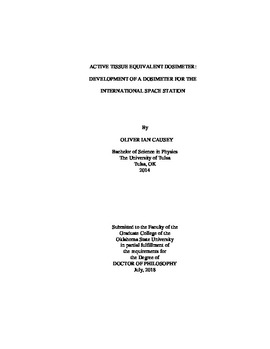| dc.contributor.advisor | Benton, Eric R. | |
| dc.contributor.author | Causey, Oliver Ian | |
| dc.date.accessioned | 2019-03-22T18:57:15Z | |
| dc.date.available | 2019-03-22T18:57:15Z | |
| dc.date.issued | 2018-07 | |
| dc.identifier.uri | https://hdl.handle.net/11244/317673 | |
| dc.description.abstract | A Tissue Equivalent Proportional Counter (TEPC) named the Active Tissue Equivalent Dosimeter (ATED) has been developed to measure absorbed dose from radiation on the International Space Station (ISS) and at aviation altitudes on commercial aircraft. The astronauts on the ISS and people in aircraft are exposed to the higher-than-normal absorbed dose rates from radiation. Galactic Cosmic Rays (GCR), Solar Energetic Particles (SEP) from Solar Particle Events (SPE), and the particles trapped in Earth's magnetic field pose the most risk for an increase in absorbed dose rates from radiation for astronauts on the ISS. There are very few tissue equivalent dosimeters on the ISS. There are controversial claims that Solar Particle Events (SPE) during solar storms and Terrestrial Gamma Flashes (TGF) during thunderstorms can cause dangerously high-absorbed dose rates for aircrew and passengers on commercial airlines. There are currently no radiation monitors on commercial aircraft in the United States. We have designed ATED to address these concerns. Extensive in-house design and redesigns of subsystems were required to ensure the system was robust enough to handle space flight. This development included methods for noise reduction, writing software, creating hardware to make the system fully embedded/stand-alone, and implementing Commercial-off-the-Shelf (COTS) parts. Adhering to NASA's strict safety guidelines required extensive testing at NASA's Johnson Space Center (JSC). The testing at JSC included characterization of radiation emission by ATED, characterization of transient signals from ATED to the ISS power source, and characterization of power conditions under which ATED can operate. Development of the unit also required extensive calibration and characterization using the Heavy Ion Medical Accelerator in Chiba, Japan (HIMAC). ATED launched to the ISS on the Orbital ATK resupply mission OA-9 on May 21, 2018. The resupply vessel docked to the ISS on May 24, 2018. The first data was transmitted down from ISS on July 19, 2018. | |
| dc.format | application/pdf | |
| dc.language | en_US | |
| dc.rights | Copyright is held by the author who has granted the Oklahoma State University Library the non-exclusive right to share this material in its institutional repository. Contact Digital Library Services at lib-dls@okstate.edu or 405-744-9161 for the permission policy on the use, reproduction or distribution of this material. | |
| dc.title | Active Tissue Equivalent Dosimeter: Development of a dosimeter for the International Space Station | |
| dc.contributor.committeeMember | Arena, Andrew S. | |
| dc.contributor.committeeMember | Borunda, Mario F. | |
| dc.contributor.committeeMember | Haley, Joseph G. | |
| osu.filename | Causey_okstate_0664D_15866.pdf | |
| osu.accesstype | Open Access | |
| dc.type.genre | Dissertation | |
| dc.type.material | Text | |
| thesis.degree.discipline | Physics | |
| thesis.degree.grantor | Oklahoma State University | |
